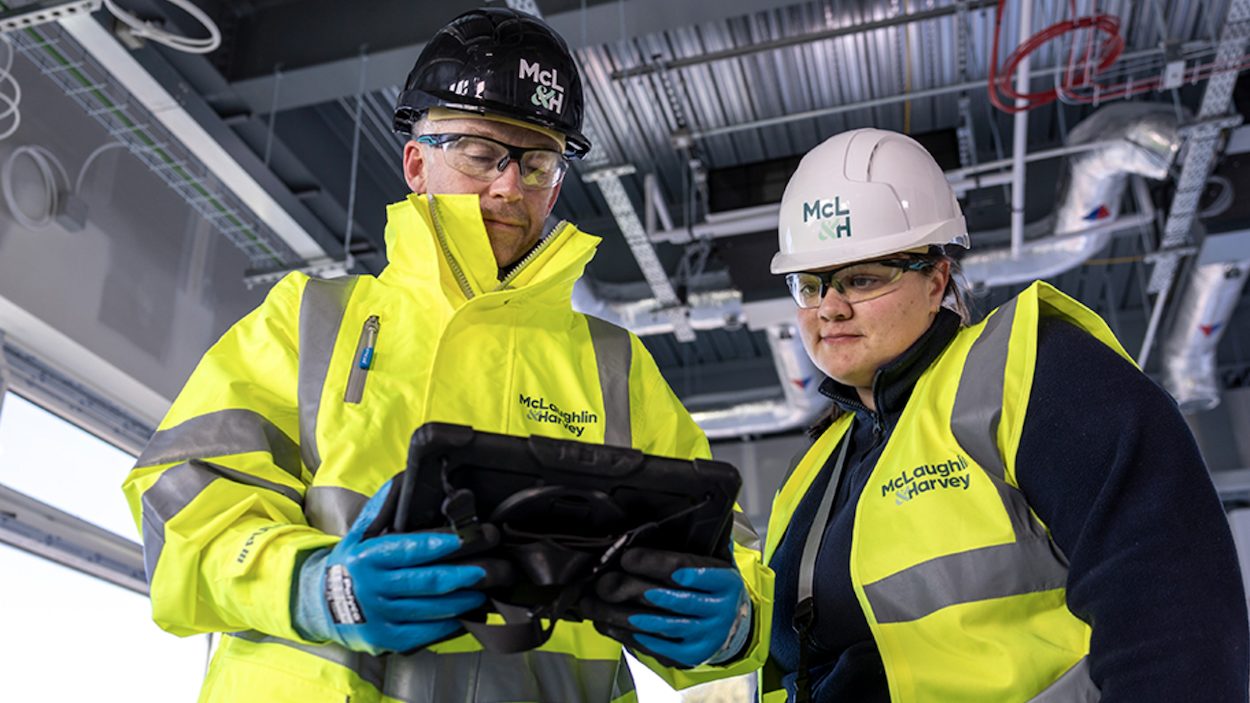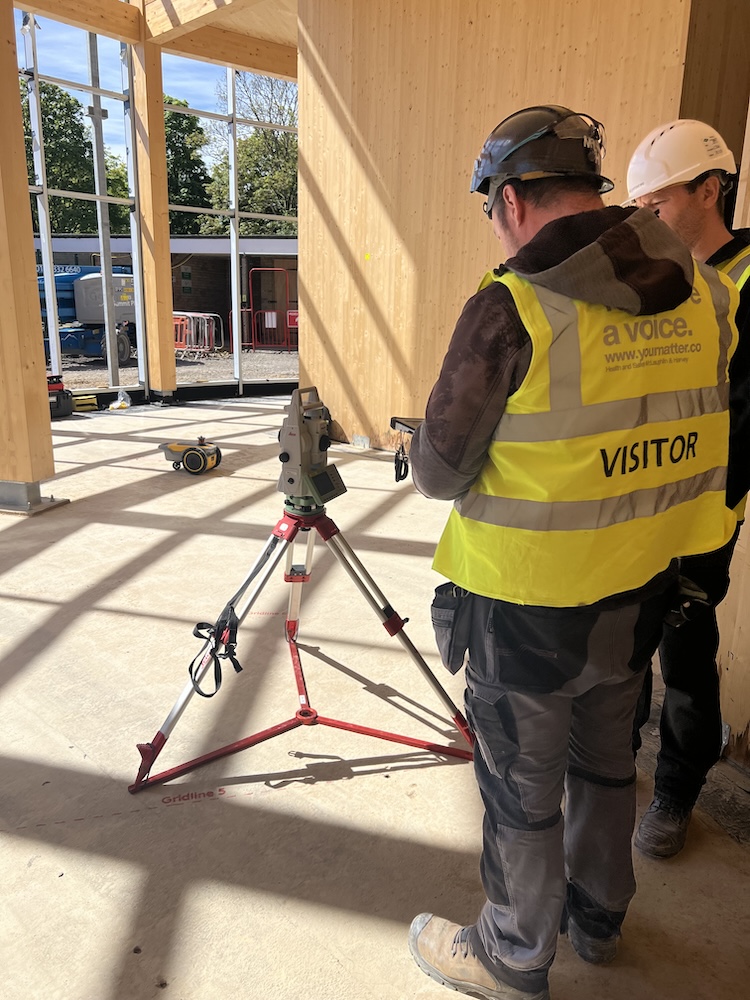
Glenn McCaffrey, digital construction director of McLaughlin & Harvey, explains the process-led approach that is the contractor’s North Star on its digital journey.
“We are all about the fundamental basics of digital construction. We’re focused on our people, processes, and technology – ultimately, providing authentic information management.” That’s what McCaffrey said in the immediate aftermath of McLaughlin & Harvey winning the Digital Contractor of the Year trophy, sponsored by Procore, at the Digital Construction Awards earlier this summer.
McLaughlin & Harvey faced intense competition from the likes of McLaren Construction and BAM UK & Ireland: ultimately, the judges responded to McCaffrey’s rigorous and common-sense approach.

“Process, process, process. Do I need to say anything else? If you don’t have a process, how do you know what supporting technology is required?"
The Belfast-headquartered construction and civil engineering contractor employs more than 800 people across the UK. It has offices in Glasgow, London, Birmingham and Bristol. It serves myriad sectors, including healthcare, education, defence, marine infrastructure, commercial, sport and industrial.
McCaffrey joined McLaughlin & Harvey in 2019 as digital construction manager (see box below) and has been promoted twice as the contractor’s board recognised the increasing importance of information management and digital construction. Since promotion to head of digital construction in 2021 (and then to director two years ago), he has grown McLaughlin & Harvey’s digital construction team from just himself to 10.
Building the digital team
Let’s start there. How did he go about recruiting the team, and what challenges did he face?
“To grow the team, there must be a demand. Most of our clients require information to be managed in accordance with BS EN ISO 19650 and delivery of asset information models. In addition to digitising processes and roll out of a CDE solution, we needed to improve our knowledge and skills on other key aspects of information management, like model management/assurance, utilisation of open BIM standards, IFC schema, and delivery of asset information models, including COBie,” he says.
From architecture to digital construction
Before joining McLaughlin & Harvey, McCaffrey was an architect for many years. “Like most senior architects, you eventually transition from designing to project managing. I found myself managing teams and producing information for clients and D&B contractors,” he says. “Even then, I was always looking for efficient ways for the team to work. It’s always been in my DNA to maximise the use of technologies and processes to be more productive and efficient.
“At that time, I was looking to diversify my knowledge. The BIM acronym was being bandied about, so I started investigating it. The more I learned, the more I realised it’s not just a 3D model; it’s an information management process. I thought, ‘this fits my skill set’.”
To get involved in BIM, he joined the larger multi-disciplinary practice WDR & RT Taggart in 2016, working on projects that required his team to produce BIM models for design coordination. He helped build an information management consultancy within the practice, guiding main contractors like McLaughlin & Harvey to assist them in the delivery of asset information models.
One conversation with McLaughlin & Harvey led to another, and McCaffrey ultimately joined its pre-construction team as digital construction manager in 2019. “We went from winning one or two projects requiring BIM to nearly 50%-60% of our jobs having that requirement in a short period of time,” he reveals. “So, I moved to delivery to establish an internal digital team and upskilling of our supply chain to help meet that demand.”
Recognising the importance of the role, the McLaughlin & Harvey board made him a director to build a dedicated team.
“We identified what skill sets were needed and what type of people could fulfil them. There was internal interest [in joining the team] – people who had a natural inclination towards information management and technology – but we had to go to external recruitment as well.”
McCaffrey sought candidates skilled in project management and BIM. “Most applicants were 3D model authors from an AEC background. We needed individuals who could transition to establishing information requirements, delivery strategies, and project management, but also have the technical skills to undertake assurance checks on asset information model deliverables. They are both project managers and technical specialists,” he notes. “I’m very blessed with a great team.”
McCaffrey expects the team to grow. “With our ability to undertake all aspects of an information manager’s role, for example, setting up the CDE, negotiating client requirements, authoring EIRs and BEPs, design coordination, and data checks, the team will continue to expand. This in-house capability has led to better project information models with useful data for site operations. With better information models, we have the foundations in place to feed into technology applications that can add value to site operations. This is the next stage of our digital evolution.”
Immune to fleeting trends
In his awards entry, McCaffrey stated: “We’ve stayed resolute, and immune to fleeting digital trends. Technology serves us, it doesn’t dictate. Our digital processes prioritise substance over hype, to meet project, client, and business needs.”
In person, he elaborates on this mindset: “Process, process, process. Do I need to say anything else? If you don’t have a process, how do you know what supporting technology is required? We sit down and first work out the process and objectives. Does the process need to be digitised? If so, we then look at the technology that might support it.
“But you must have a defined process initially. Starting with technology leads you down all sorts of rabbit holes about what it can do, rather than focusing on what you want to achieve in the first place. Technology cannot become the tail that wags the dog.
“We have formed an IT strategy group that meets monthly, including board members, operations directors, design management, quality, and finance. I chair these meetings where we discuss new ideas, review our tech stack, ensure it’s functioning as intended, and identify any necessary tweaks or redundancies. Again, it’s all about process, process, process and added value to our business.”

McCaffrey emphasises that identifying useful technologies is a collaborative effort. “We preach the message, ‘if you think there’s something that can help you, come and talk to us about it’.”
He cites an example from a UK Atomic Energy Authority project, where setting out a circular building posed a challenge. The site engineer asked if there was any technology that could help. He mentioned seeing a YouTube clip of HP’s SitePrint robot. “We investigated it and within a fortnight, we had that robot on site, linked to the project model, setting out.”
More site technology
As McLaughlin & Harvey’s digital journey progresses, the increased use of site technology remains a key focus. He explains: “We’re exploring augmented reality and mixed reality for building services to see how they might help us with checking onsite installations and verification and validation of construction record models for handover, or how it might help us with collation of data sets for maintainable assets.”
AI is also under McCaffrey’s microscope. “Like everyone else, we’re exploring AI. Many of our processes are specific to the digital construction department, and we’re seeking AI solutions to automate certain manual tasks.
“We’re examining ourselves from a data perspective. We’ve realised the power of mining the data sets we already hold about our business.”
"For example, our QA checks on information containers to ensure compliance with the project’s standards required extensive manual input. We’ve built an AI bot that bulk scans the title blocks of the information containers to ensure file names, revision numbers, and status codes etc, align with the project’s information standards, the master information delivery plan and unique ID on our CDE. It produces a report, flagging inconsistencies for review by our digital construction coordinators, thus reducing manual work.
“The objective is to spend less time preparing reports and more time analysing results and expediting corrective actions."
McLaughlin & Harvey is also introspective. As our interview concludes, McCaffrey reveals: “We’re examining ourselves from a data perspective. We’ve realised the power of mining the data sets we already hold about our business. This is a massive transformation, and I see it growing over time. We will make business decisions based on hard facts, data analytics and trend analysis.”
Don’t miss out on BIM and digital construction news: sign up to receive the BIMplus newsletter.














